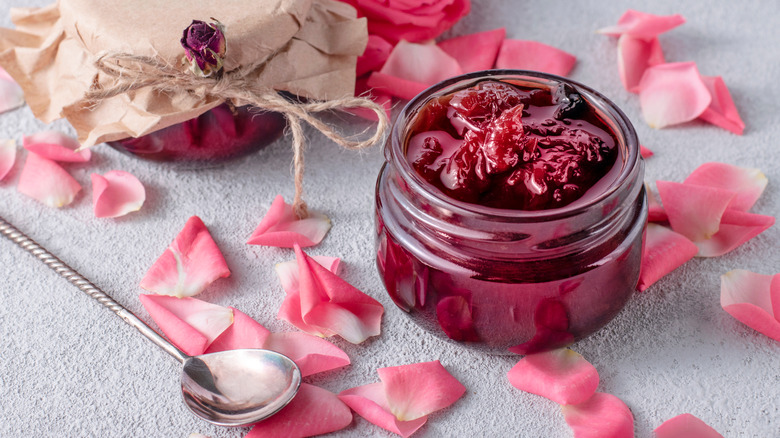What Fireweed Jelly Has To Do With Alaskan Wildfires
The raging fury of a wildfire seems incongruous with the gentle nature of delicate flowers. And when an edible element gets thrown in the mix, the mystery deepens — specifically when it's the sweet and spicy fireweed jelly. But the three components have more in common than you might imagine. One begets the other in certain circumstances, select environments, and chef proclivities. It all comes down to the herbaceous, flowering, scientifically named Chamerion angustifolium plant, commonly known as fireweed.
Fireweed blooms and blazes with color for about four months every year, roughly from June through September, according to the United States Department of Agriculture (USDA). A publication from the USDA's Natural Resource Conservation Services notes that fireweed grows primarily in northern climates such as Alaska, the Pacific Northwest, and Canada. However, it can also appear deeper south into North Carolina and west into California and New Mexico.
Four vibrant magenta or rose-colored petals adorn each flower, perched atop stems stretching upward 3 to 5 feet, per the Lady Bird Johnson Wildflower Center in Texas. Slender petal pods harbor numerous seeds, which become wind-borne when released by wispy white tufts of "hair," accounting for fireweed's prolific ground cover across wide expanses of forests, woodlands, and meadows, explains the USDA. It's that ability to spread and thrive that leads to culinary cultivation, including use in fireweed jelly and honey.
But first, the blazing fury of fire consumes the wild forest habitat.
From flames to flavor
Fireweed flourishes in what the USDA Forest Service calls "disturbed soil." This can mean intentional clearing, but most often results from forest fires consuming natural habitats, including those of Alaska. The fireweed plant is an early arriver after fire disturbance, being one of the first plants to lay down roots and quickly spread, blanketing barren landscapes in a flurry of flowers. This gives rise to the fireweed name, cemented by the flower's lance-like shape coincidentally simulating the appearance of a flame.
Fireweed is an easy grab for foraging animals such as deer, moose, elk, and grizzly bears, and the flowers are magnets for pollinating bees, supporting the flourishing Canadian honey industry, notes USDA. But a smaller yet devoted segment of food creators are also part of the firewood story: the fireweed jelly makers. Atlas Obscura notes that the season for fireweed jelly is short, with locals boiling the flowers and adding pectin, sugar, and lemon juice to create the spicy/sweet jelly.
Fireweed as a culinary ingredient is nothing new, per the USDA, which notes long-term use of fireweed stems by Native Americans and First Nations People. A publication of the Alaska Center for Native Health Research provides meal ideas for ciilaaq, including boiling it like asparagus or consuming raw in salads. The Huna Heritage Foundation also reveals medicinal uses and nutritional values, including high amounts of fiber and vitamins C and A.

